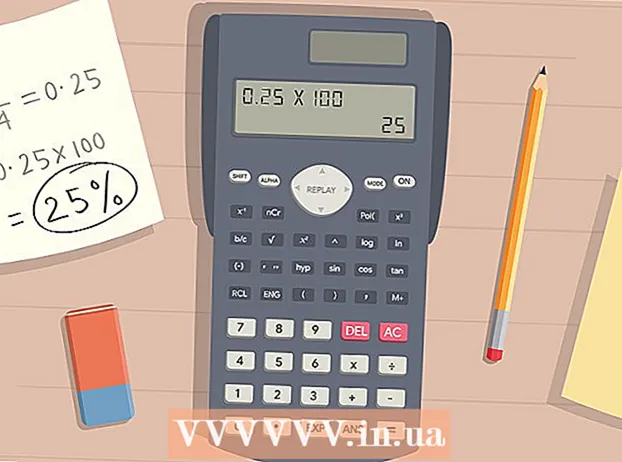Author:
William Ramirez
Date Of Creation:
18 September 2021
Update Date:
17 June 2024

Content
- Steps
- Part 1 of 3: Calculating the Volume of a Regularly Shaped Body
- Part 2 of 3: Calculating the Volume of an Irregular Body
- Part 3 of 3: Calculating Density
- Tips
- Warnings
Volume is the amount of space a body occupies, and density is equal to the body's mass divided by its volume. Before calculating the density of a body, you need to find its volume. If the body has the correct geometric shape, its volume can be calculated using a simple formula. Volume is usually measured in cubic centimeters (cm) or cubic meters (m). Using the found volume of the body, it is easy to calculate its density. Density is measured in grams per cubic centimeter (g / cm) or grams per milliliter (g / ml).
Steps
Part 1 of 3: Calculating the Volume of a Regularly Shaped Body
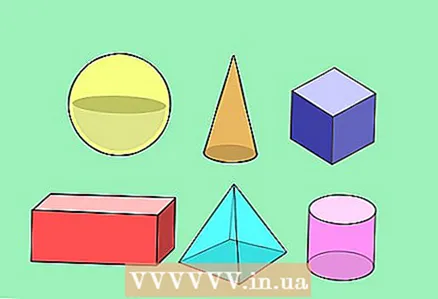 1 Determine your body shape. Knowing the shape will allow you to select the correct formula and take the measurements needed to calculate the volume.
1 Determine your body shape. Knowing the shape will allow you to select the correct formula and take the measurements needed to calculate the volume. - Sphere is a perfectly circular three-dimensional object, all surface points of which are equidistant from the center. In other words, a spherical body is like a round ball.
- Cone Is a three-dimensional shape with a circle at its base and a single point at its top, called the apex of a cone. A cone can also be thought of as a pyramid with a round base.
- Cube is a three-dimensional shape made up of six identical square faces.
- Rectangular parallelepiped, also called a rectangular prism, is similar to a cube: it also has six faces, but in this case they are rectangles, not squares.
- Cylinder Is a three-dimensional shape, consisting of identical round ends, the edges of which are connected by a rounded surface.
- Pyramid is a three-dimensional shape, at the base of which lies a polygon, which is connected to the vertex by side faces. A regular pyramid is a pyramid whose base is a regular polygon, all sides and angles of which are equal to each other.
- If the body is irregular, its volume can be found by completely submerging it in water.
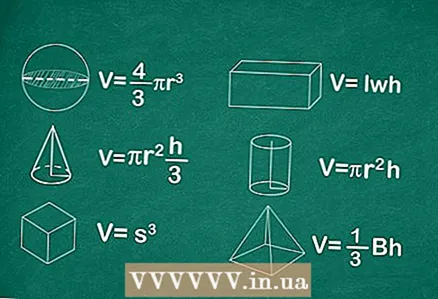 2 Select the correct equation to calculate the volume. Each body type has its own formula that allows you to calculate the volume it occupies. Below are the formulas for finding the volume of the above figures. More details and illustrations can be found in the article How to find volume.
2 Select the correct equation to calculate the volume. Each body type has its own formula that allows you to calculate the volume it occupies. Below are the formulas for finding the volume of the above figures. More details and illustrations can be found in the article How to find volume. - Sphere: V = (4/3) π rwhere r is the radius of the sphere and π is a constant of about 3.14.
- Cone: V = (1/3) π rhwhere r is the radius of the round base, h is the height of the cone, π is a constant of approximately 3.14.
- Cube: V = s, where s is the length of the edge of the cube (sides of any of its square faces).
- Rectangular parallelepiped: V = l x w x h, where l is the length of the rectangular face, w is its width, h is the height of the parallelepiped (prism).
- Cylinder: V = π rh , where r is the radius of the round base, h is the height of the cylinder, π is a constant of approximately 3.14.
- Pyramid: V = (1/3) b x h, where b is the area of the base of the pyramid (l x w), h is the height of the pyramid.
 3 Take the required measurements. They will depend on what kind of body you are dealing with. For most bodies of simple shape, you will need to measure the height; if the figure has a round base, it is also necessary to determine its radius, but if a rectangle lies at the base - its length and width.
3 Take the required measurements. They will depend on what kind of body you are dealing with. For most bodies of simple shape, you will need to measure the height; if the figure has a round base, it is also necessary to determine its radius, but if a rectangle lies at the base - its length and width. - The radius of a circle is half its diameter. Measure the diameter by attaching a ruler to the middle of the circle, then divide the result by 2.
- The radius of a sphere is a little more difficult to measure, but it will not be difficult if you use the methods detailed in the article How to find the radius of a sphere.
- The length, width and height of the body can be determined by attaching a ruler to it in the appropriate places and recording the measurement results.
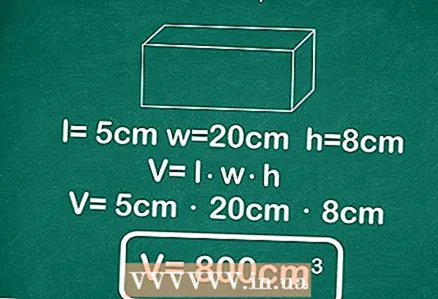 4 Calculate the volume. Having found out the shape of the body, choose a suitable formula and measure the quantities included in it. Plug in the measured values into the formula and perform the necessary mathematical steps. As a result, you will get body volume.
4 Calculate the volume. Having found out the shape of the body, choose a suitable formula and measure the quantities included in it. Plug in the measured values into the formula and perform the necessary mathematical steps. As a result, you will get body volume. - Remember that the answer must be expressed in cubic units, regardless of which system of units you use (metric or other). After the received value, be sure to write the units in which it is measured.
Part 2 of 3: Calculating the Volume of an Irregular Body
 1 Determine the volume of the body by the amount of water displaced by it. The body can be irregular in shape, which makes it difficult to measure its size and leads to inaccurate determination of volume. In this case, the method works great, which consists in determining the volume of water displaced by the body during full immersion.
1 Determine the volume of the body by the amount of water displaced by it. The body can be irregular in shape, which makes it difficult to measure its size and leads to inaccurate determination of volume. In this case, the method works great, which consists in determining the volume of water displaced by the body during full immersion. - This method can also be used to find the volume of bodies of the correct shape in order to avoid calculations.
 2 Fill the graduated cylinder (beaker) with water. It is a labeled container on the side for measuring the volume of liquids. Select a cylinder large enough to completely fit the object to be measured. It is necessary to fill the cylinder with water so that the object can be completely immersed in it, but at the same time it does not pour out. Record the initial volume of water excluding the measured body.
2 Fill the graduated cylinder (beaker) with water. It is a labeled container on the side for measuring the volume of liquids. Select a cylinder large enough to completely fit the object to be measured. It is necessary to fill the cylinder with water so that the object can be completely immersed in it, but at the same time it does not pour out. Record the initial volume of water excluding the measured body. - While observing the initial volume of water, bend over so that your eyes are level with the surface of the liquid, and then write down the height at which the bottom of the meniscus is located. The meniscus is the outer surface of water that bends when in contact with other surfaces (in our case, these are the walls of the vessel).
 3 Place the body to be measured carefully into the container. Do this smoothly so as not to drop the object, as this may cause some of the water to splash out of the graduated cylinder. Make sure your body is completely submerged in water. Record the new reading of the water level in the container, again positioning your eyes so that your eyes are level with the meniscus.
3 Place the body to be measured carefully into the container. Do this smoothly so as not to drop the object, as this may cause some of the water to splash out of the graduated cylinder. Make sure your body is completely submerged in water. Record the new reading of the water level in the container, again positioning your eyes so that your eyes are level with the meniscus. - If some of the water splashes out when you submerge your body, try repeating from the beginning, pouring less water or using a larger graduated cylinder.
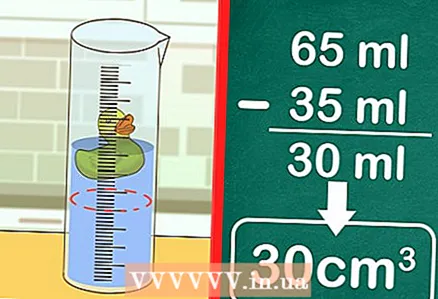 4 Subtract the original value from the final water level. The amount of water displaced by the object will be equal to its volume in cubic centimeters. Usually the volume of liquids is measured in milliliters, but one milliliter is exactly equal to one cubic centimeter.
4 Subtract the original value from the final water level. The amount of water displaced by the object will be equal to its volume in cubic centimeters. Usually the volume of liquids is measured in milliliters, but one milliliter is exactly equal to one cubic centimeter. - For example, if at first the water level was 35 ml, and after lowering the object into it, it rose to 65 ml, the volume of this object is 65 - 35 = 30 ml, or 30 cm.
Part 3 of 3: Calculating Density
 1 Determine the mass of the item. The mass of an object corresponds to the amount of matter of which it is composed. The mass is found by direct weighing on a balance, it is measured in grams or kilograms.
1 Determine the mass of the item. The mass of an object corresponds to the amount of matter of which it is composed. The mass is found by direct weighing on a balance, it is measured in grams or kilograms. - Take a precision weighing scale and place an object on top of it. Record the scale reading in your notebook.
- Body weight can also be determined using a scale. Putting the object on one bowl, on the other place weights with known masses so that both bowls balance each other, being at the same height. In this case, the desired mass of the object will be equal to the sum of the masses of the weights used.
- Before weighing, make sure that the object is not wet, otherwise the measurement error will increase.
 2 Determine your body volume. If the object has the correct shape, use one of the formulas above to determine its volume. If the shape of the body is not correct, measure the volume by submerging it in water as described above.
2 Determine your body volume. If the object has the correct shape, use one of the formulas above to determine its volume. If the shape of the body is not correct, measure the volume by submerging it in water as described above. 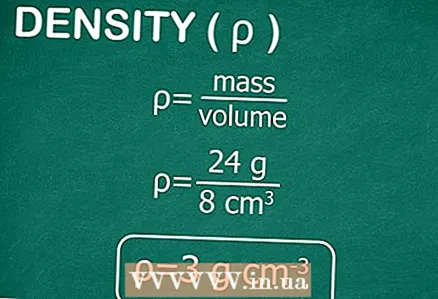 3 Calculate the density. By definition, density is equal to mass divided by volume. Thus, divide the measured mass by the calculated volume. As a result, you get the density of the body, measured in g / cm.
3 Calculate the density. By definition, density is equal to mass divided by volume. Thus, divide the measured mass by the calculated volume. As a result, you get the density of the body, measured in g / cm. - For example, let's calculate the density of an object with a volume of 8 cm and a mass of 24 g.
- density = mass / volume
- d = 24 g / 8 cm
- d = 3 g / cm
Tips
- Often, objects consist of several parts that have regular geometric shapes. In this case, divide the constituent elements into groups related to one or another correct form, find the volume of each element, and then add them together, thereby determining the total volume of the entire object.
- You can determine the volume of an object both by calculation and by immersion in water, and then compare the results.
Warnings
- Be careful: before proceeding with the calculations, be sure to convert all measured values to the metric system (SI system of units).

